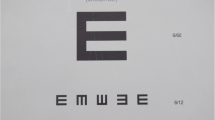Abstract
Purpose
The primary aim of this study was to assess the practice behaviors of physicians on pediatric vision screening (VS) in primary care settings in Turkey and compare the groups in respect of previous education on VS.
Methods
All physicians working in the primary care settings of Kayseri province of Turkey were directly administered a 24-item questionnaire at planned education seminars. The groups were compared according to a history of VS education (Group 1) and no history of VS education (Group 2). The self-reported questionnaire results were analyzed statistically.
Results
A total of 124 of 453 physicians completed the survey with a response rate of 27.3%. VS was reported to be performed as recommended by 70.2% of the participants. The physicians in Group 1 were significantly older (P < 0.05) and more experienced (P < 0.05) than those in Group 2. Group 1 performed the red reflex (RR) test significantly more frequently (P < 0.05) and referred the patients to an ophthalmologist less frequently than Group 2 (P < 0.05). Regression analysis revealed that age (P < 0.05) and previous education (P < 0.05) were the independent factors for visual acuity and RR testing, respectively. Practice-related factors were the most commonly reported barriers to VS in primary care settings.
Conclusion
Although there is a high rate of reported full adherence to the recommendations for pediatric VS, it seems to be more likely to be performed insufficiently. Practice-related barriers should be handled by publicly available education materials (e.g., YouTube videos). VS education should be added at an earlier stage of medical training programs.

Similar content being viewed by others
Availability of data and material
The data is available upon request.
References
Holmes JM, Clarke MP (2006) Amblyopia. Lancet 367(9519):1343–1351
Wallace DK, Repka MX, Lee KA, Melia M, Christiansen SP, Morse CL, Sprunger DT (2018) Amblyopia preferred practice pattern. Ophthalmology 125(1):P105. https://doi.org/10.1016/j.ophtha.2017.10.008
Azizoğlu S, Crewther SG, Şerefhan F, Barutchu A, Göker S, Junghans BM (2017) Evidence for the need for vision screening of school children in Turkey. BMC Ophthalmol 17(1):230. https://doi.org/10.1186/s12886-017-0618-9
Caca I, Cingu AK, Sahin A, Ari S, Dursun ME, Dag U, Balsak S, Alakus F, Yavuz A, Palanci Y (2013) Amblyopia and refractive errors among school-aged children with low socioeconomic status in southeastern Turkey. J AAPOS Offic Publ Am Assoc Pediatr Ophthalmol Strabismus 50(1):37–43
Holmes JM, Lazar EL, Melia BM, Astle WF, Dagi LR, Donahue SP, Frazier MG, Hertle RW, Repka MX, Quinn GEJAoo, (2011) Effect of age on response to amblyopia treatment in children. Arch Ophthalmol 129(11):1451–1457. https://doi.org/10.1001/archophthalmol.2011.179
Donahue SP, Nixon CN (2016) Visual system assessment in infants, children, and young adults by pediatricians. Pediatrics 137(1):28–30. https://doi.org/10.1542/peds.2015-3596
Hered RW, Rothstein M (2003) Preschool vision screening frequency after an office-based training session for primary care staff. Pediatrics 112(1):e17–e21. https://doi.org/10.1542/peds.112.1.e17
Marsh-Tootle WL, McGwin G, Kohler CL, Kristofco RE, Datla RV, Wall TC (2011) Efficacy of a web-based intervention to improve and sustain knowledge and screening for amblyopia in primary care settings. Invest Ophthalmol Vis Sci 52(10):7160–7167. https://doi.org/10.1167/iovs.10-6566
Clausen MM, Armitage MD, Arnold RW (2009) Overcoming barriers to pediatric visual acuity screening through education plus provision of materials. J AAPOS Offic Publ Am Assoc Pediatr Ophthalmol Strabismus 13(2):151–154
Williams S, Wajda BN, Alvi R, McCauley C, Martinez-Helfman S, Levin AV (2013) The challenges to ophthalmologic follow-up care in at-risk pediatric populations. J AAPOS Offic Publ Am Assoc Pediatr Ophthalmol Strabismus 17(2):140–143. https://doi.org/10.1016/j.jaapos.2012.11.021
Administration TPH (2020) National Visual screening programme education contents for health professionals narrated by Huban Atilla. YouTube. https://www.youtube.com/watch?v=Lzm2QS-mRWA
Özkurt ZG, Balsak S, Çamçi MS, Bilgen K, Katran İH, Aslan A, Han ÇÇ (2019) Approach of family physicians to pediatric eye screening in Diyarbakır. Turk J Ophthalmol 49(1):25
Kemper AR, Clark SJ (2007) Preschool vision screening by family physicians. J Pediatr ophthalmol Strabismus 44(1):24–27
Le TD, Raashid RA, Colpa L, Noble J, Ali A, Wong A (2018) Paediatric vision screening in the primary care setting in Ontario. Paediatr Child Health 23(3):e33–e39. https://doi.org/10.1093/pch/pxx148
Kemper AR, Fant KE, Badgett JT (2003) Preschool vision screening in primary care after a legislative mandate for diagnostic eye examinations. South Med J 96(9):859–862. https://doi.org/10.1097/01.Smj.0000054937.26303.95
Asch DA, Jedrziewski MK, Christakis NA (1997) Response rates to mail surveys published in medical journals. J Clin Epidemiol 50(10):1129–1136. https://doi.org/10.1016/s0895-4356(97)00126-1
Acknowledgments
None.
Funding
None.
Author information
Authors and Affiliations
Contributions
S.G designed the study, collected the data, drafted the manuscript, and created the tables.
Corresponding author
Ethics declarations
Conflicts of interest
The author reports no conflicts of interest. The author alone is responsible for the content and writing of the paper.
Ethics approval
Kayseri Erciyes University, Clinical Investigations Ethics Committee, 20.01.2020/35.
Consent to participate
Consent forms were obtained from all participants.
Consent for publication
Consent forms were obtained from all participants.
Additional information
Publisher's Note
Springer Nature remains neutral with regard to jurisdictional claims in published maps and institutional affiliations.
Supplementary Information
Below is the link to the electronic supplementary material.
Rights and permissions
About this article
Cite this article
Guven, S. The effect of education seminars on pediatric vision screening in the primary care settings. Int Ophthalmol 42, 635–644 (2022). https://doi.org/10.1007/s10792-021-02037-z
Received:
Accepted:
Published:
Issue Date:
DOI: https://doi.org/10.1007/s10792-021-02037-z




